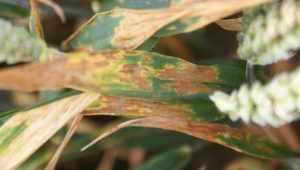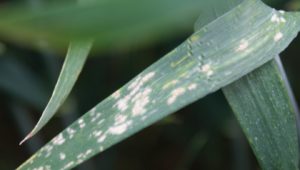Early disease management in cereals
19 March 2018The vanishing snow will leave ground conditions wetter than ever so we are probably some way away from early fungicide treatments in winter wheat and barley crops. Fortunately the need for treatment this year is probably slightly reduced compared to a year ago as the ‘proper’ winter weather has helped to keep disease levels down and, for example, there are still no reports of yellow rust in wheat.
The main disease spray programmes start at early stem extension in winter barley and at leaf 3 emerged in winter wheat. Both are now commonly termed ‘T1’ sprays although in wheat there is an emerging trend to call the spray timings by the leaf layer at which it should be aimed. That is where the two crops differ as the T1 spray in barley is genuinely aimed at early stem extension in order to preserve as many side tillers as possible as this will ultimately let the crop set as many grain sites as possible and hence have the highest yield potential. In wheat though the point of the T1 spray is to protect final leaf three and it just so happens that this tends to coincide with stem extension and growth stage 32, which is where two nodes are detectable at stem extension. Going earlier on wheat at growth stage 31 (one node detectable) will target final leaf 4 or 5 so that there will be very long gap until the flag leaf spray.

Septoria is really damaging to yield when it is severe on the upper leaves of wheat so best protection targets exact leaf layers.
In both wheat and barley though those official starts to the spray programme can be a long wait where disease levels are clicking upwards and so the use of early T0 sprays before the T1 is common. But these should be tailored to each crop situation and because yield responses are small they are the easiest sprays to drop where risk is low. In wheat if septoria is the only concern then waiting to leaf 3 emerging is possible without compromising later septoria control – SRUC trials show the yield responses where septoria was the only disease and was only present at low levels at this T0 timing are usually below the economic cost of treatment. But that has to be a carefully considered choice – you would not be as relaxed about leaving a variety like Myriad with a ‘4’ rating for rust untreated, compared to a variety like KWS Barrel which has an ‘8’ rating for yellow rust. Leeds is rated ‘3’ for mildew and so may need early treatment for this disease. On other more robust varieties be guided by past experience of how mildew tends to develop on the farm. Mildew is very visible so tends to cause concern where it is seen but spot for spot it is nowhere near as damaging as other diseases so it is an example where it is possible to tolerate a few spots if it doesn’t usually flare up on your farm.

Powdery mildew is very site and variety specific so yield losses at low risk sites can be very small.
Similarly winter barley T0s can be tailored to the risk. Varieties like Tower and Cassia have low to middling ratings for the key diseases and a holding spray might be more necessary than on the high yielding KWS Cresswell, Orwell and Infinity group which are all rated ‘6’ for rhynchosporium. But that has to be done in the practical context of the many other jobs that might be on-going at stem extension and being pragmatic about the risk that T1 sprays might be delayed by other tasks or indeed by a run of windy, wet weather. For both crops, if you do choose to use a T0 then try and use different chemistry to later sprays to protect against fungicide resistance development.
Fiona Burnett (SRUC) for the Farm Advisory Service
Sign up to the FAS newsletter
Receive updates on news, events and publications from Scotland’s Farm Advisory Service


